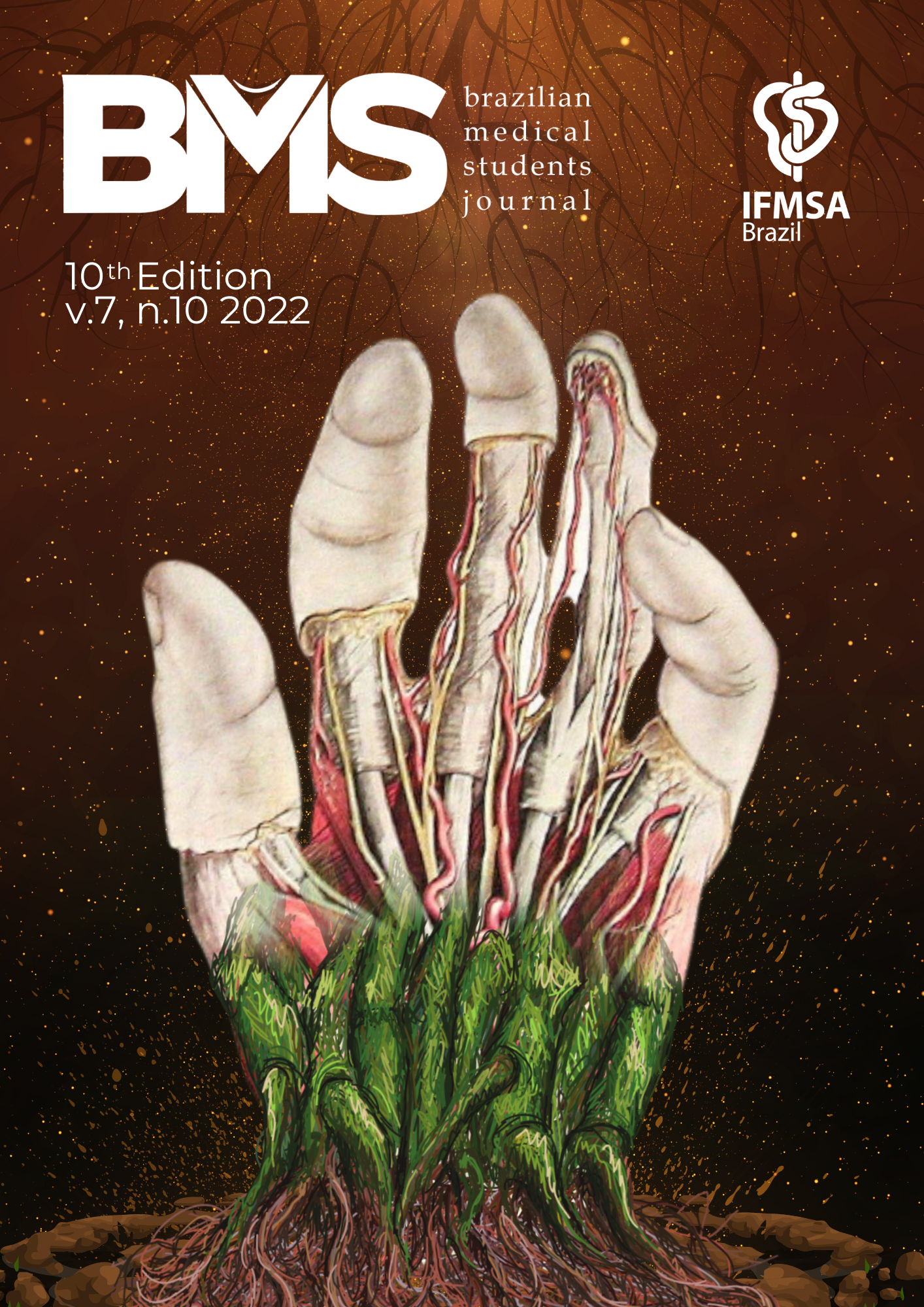AÇÃO “VAMOS JUNTOS PREVENIR O CÂNCER DE MAMA?”: UM RELATO DE EXPERIÊNCIA
DOI:
https://doi.org/10.53843/bms.v7i10.400Palabras clave:
Neoplasias da Mama, Promoção da Saúde, Prevenção de Doenças, ConscientizaçãoResumen
Introdução: O câncer de mama apresenta uma alta incidência em pessoas do sexo feminino e é o maior responsável pelos óbitos decorrentes de neoplasias nas mulheres brasileiras. Nos casos precocemente diagnosticados, é fatídico um bom prognóstico de cura e tratamento, embora esse rastreamento prévio não seja realidade no país, justificando a elevada epidemiologia dessa doença. Sendo assim, torna-se justificável o fomento de ações de conscientização que incentivem mulheres a realizarem o check up, através da mamografia, principalmente, a fim de que o Brasil se afaste do perfil de subdesenvolvimento no rastreio do câncer de mama. Relato da experiência: “Vamos juntos prevenir o câncer de mama?” foi a atividade idealizada por 12 estudantes de medicina, por meio de reuniões mensais da liga acadêmica de mastologia, que objetivava conscientizar as mulheres sobre a prevenção do câncer de mama. O evento em questão ocorreu presencialmente nas proximidades da instituição de ensino, com auxílio de materiais visuais de apoio, por meio de informações oferecidas aos transeuntes pelos ligantes acerca da mamografia, autoexame, sinais de alerta e fatores de risco para o câncer de mama, além de outros tópicos. Discussão: Por meio da atividade desenvolvida, notou-se interesse na discussão por parte das ouvintes atentas, através de devolutivas pessoais e dúvidas construídas por meio de perguntas, de forma a efetivar os objetivos previamente estabelecidos para disseminar o conhecimento. A repercussão positiva foi também evidenciada pelo considerável número de pessoas alcançadas na ação. Conclusão: Com os resultados notados durante a ação, a atividade se mostrou operante na tentativa de conscientizar as mulheres acerca da neoplasia mamária. Desse modo, destaca-se a relevância de atividades informativas, que devem ser reproduzidas, a fim de alcançar melhores estatísticas sobre a realidade do câncer de mama no Brasil.
Métricas
Citas
Instituto Nacional de Câncer José Alencar Gomes da Silva. Estimativa 2020: Incidência do Câncer no Brasil. Rio de Janeiro: INCA; 2019 [acesso em 12 mai 2022]. Disponível em: hDttps://www.inca.gov.br/sites/ufu.sti.inca.local/files//media/document//.
Lima LT, Donato MAM. Perfil epidemiológico do câncer de mama no Brasil: Um resgate da literatura. Caderno de Graduação-Ciências Biológicas e da Saúde-UNIT-PERNAMBUCO, v. 4, n. 3, p. 62-62, 2020.
Instituto Nacional de Câncer José Alencar Gomes da Silva. Atlas da mortalidade [Internet]. Rio de Janeiro: INCA; 2021 [acesso em 11 mai 2022]. Disponível em: https://www.inca.gov.br/app/mortalidade.
Instituto Nacional de Câncer José Alencar Gomes da Silva. Diretrizes para a Detecção Precoce do Câncer de Mama no Brasil. Rio de Janeiro, 2015 [acesso em 11 mai 2022]. Disponível em: https://www.inca.gov.br/publicacoes/livros/diretrizes-para-deteccao-precoce-do-cancerde-mama-no-brasil. DOI: https://doi.org/10.32635/2176-9745.RBC.2016v62n1.415
Ministério da Saúde. Secretaria de Atenção à Saúde. Departamento de Atenção Básica. Caderno de Atenção Primária / Ministério da Saúde. Brasília: Ministério da Saúde; 2010; p. 71-72.
dos Santos L, Nogueira de Oliveira Martins T, Baldissera C, Brondani Pagliarin Silva A, Medeiros Braz M, Maria Foletto Pivetta H. Trilha sensitiva: estratégia para conscientização do diagnóstico precoce do câncer de mama. Anais do Salão Internacional de Ensino, Pesquisa e Extensão 2020 Fev;9(3). Disponível em: https://periodicos.unipampa.edu.br/index.php/SIEPE/article/view/86266
de Lima LT, Donato MAM. Perfil epidemiológico do câncer de mama no Brasil: Um resgate da literatura. Caderno de Graduação-Ciências Biológicas e da Saúde-UNIT-PERNAMBUCO 2020 Dez;4(3):62-62.
Bernardes NB et al. Câncer de Mama X Diagnóstico / Breast Cancer X Diagnosis. ID On Line Revista de Psicologia 2019 Fev;13(44):877-855 [acesso em: 18 mai 2022]. Disponível em http://dx.doi.org/10.14295/idonline.v13i44.1636. DOI: https://doi.org/10.14295/idonline.v13i44.1636
McCowan C et al. Identifying suspected breast cancer: development and validation of a clinical prediction rule. Br J Gen Pract 2011 Mai;61(586):e205-e214. DOI: https://doi.org/10.3399/bjgp11X572391
de Castro FA, Vasconcelos FL. Impacto do autoexame das mamas no diagnóstico de câncer de mama em países de média e baixa renda: uma revisão de literatura. Brazilian Journal of Health Review 2021;4(1):2973-2996. DOI: https://doi.org/10.34119/bjhrv4n1-238
Rosa DD et al. The impact of sociodemographic factors and health insurance coverage in the diagnosis and clinicopathological characteristics of breast cancer in Brazil: AMAZONA III study (GBECAM 0115). Breast Cancer Research and Treatment 2020 183(3):749-757. DOI: https://doi.org/10.1007/s10549-020-05831-y
Rezende MCR. Causas do diagnóstico tardio no câncer de mama [dissertação]. Rio de Janeiro: Universidade Federal do Rio de Janeiro; 2010.
Rezende MC, Koch HA, Figueiredo JA, Thuler LCS. Factors leading to delay in obtaining definitive diagnosis of suspicious lesions for breast cancer in a dedicated health unit in Rio de Janeiro. Rev Bras Ginecol Obstet 2009; 31(2):75-81. DOI: https://doi.org/10.1590/S0100-72032009000200005
Coelho AKR et al. Conscientização em alusão ao Outubro Rosa: vamos falar sobre câncer de mama?. Research, Society and Development 2021;10(14):e233101422137-e233101422137. DOI: https://doi.org/10.33448/rsd-v10i14.22137
Martins FP, Ribeiro DFS, Gaspar DRFA, Nascimento ACFM, Souza DC, Felippe TDG. Outubro Rosa: Facilitando o acesso, promovendo à saúde e prevenindo agravos à saúde da mulher. Revista Rede de Cuidado em Saúde 2017;10(1):1-4.
Descargas
Publicado
Cómo citar
Número
Sección
Licencia
Derechos de autor 2022 Ana Karine Ribeiro de Vasconelos, Camila Parlow, Ana Cecília Miranda, Ana Sofia Carvalho Fonseca e Albuquerque, Clara de Andrade Pontual Peres

Esta obra está bajo una licencia internacional Creative Commons Atribución 4.0.
Las licencias de usuario definen cómo los lectores y el público en general pueden utilizar el artículo sin requerir otros permisos. Las licencias públicas Creative Commons proporcionan un conjunto estándar de términos y condiciones que los creadores y otros titulares de derechos pueden utilizar para compartir obras originales de autoría y otros materiales sujetos a derechos de autor y otros derechos específicos especificados en la licencia pública disponible en https:// creativecommons.org /licenses/by/4.0/deed.pt_BR. Al utilizar la Licencia Pública Internacional 4.0, los Estudiantes de Medicina de Brasil (BMS) otorgan al público permiso para utilizar el material publicado en los términos y condiciones especificados y acordados por la revista. Al ejercer los derechos de licencia, los autores aceptan y aceptan estar sujetos a los términos y condiciones de la Licencia Pública Internacional Creative Commons Attribution 4.0.






